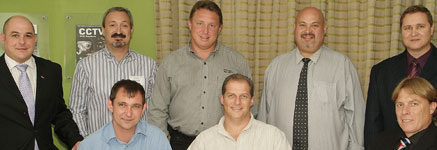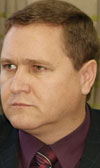

The common view is that remote monitoring companies have banks of video screens being monitored by rows of operators struggling to stay awake. The Hi-Tech Security Solutions round-table on remote monitoring proved the reality is far more complex.
Remote monitoring, or off-site monitoring is not a new idea in the security world, but the advance of technology is changing the way in which companies are offering remote services as well as what customers have come to expect from their service providers.
On the one hand, there are those that offer live monitoring of locations and assets, done with operators monitoring live video streams for specific events, acting as managers to each client’s security processes. Alternatively, there are companies that rely on technology to warn operators when an event occurs. These companies operate on an anomaly basis, warning the operators when specific events are triggered using intelligent surveillance technologies.

Anthony Rosenbaum, MD of CMT Trading says that although off-site video monitoring has been around for years, he still feels there is plenty of potential in this country to expand the services on offer. One of the reasons for this is that the market hasn’t been well educated in terms of what remote site surveillance is. “Many people consider remote surveillance as straight CCTV operations,” says Rosenbaum. “They don’t understand the capabilities of true off-site or remote monitoring.”

Philip Smerkovitz, MD of TeleEye says the company has seen a steady uptake over the last few years, particularly of video alarm verification services. Some corporates are even building their own management control centres, while others are outsourcing the management roles to remote video response centres that traditionally offered video alarm verification services.

In this scenario, the site equipment is offline from the control room until such time as an event takes place at the site being monitored. The site equipment then initiates a dial-back connection to the control room. In other words, the control room monitors on exception. Moreover, these control rooms are being tasked with handling more management services, such as health and safety, compliance, and so on.
Alvin Flaum, MD of Stallion Security says different industries in South Africa are opting for the type of monitoring solutions that meet their requirements. “If you look at the banking industry, you will find that they are doing the monitoring themselves, building their own monitoring centres and so on. On the other hand, if you look at the industrial warehousing side of the market, they’re outsourcing almost everything.”

Mark de Koker, interactive remote monitoring centre manager, Omega Risk Solutions, adds that people are not aware of the different types of remote monitoring available. “Most people think about CCTV and see a whole host of cameras. The reality is that effective surveillance is a combination of things, including guarding.

The question of guards
The issue of whether guards are still necessary is a contentious one. On the one hand, there are those who are adamant that guards are part of the solution, while on the other, some say it is best to keep guards to a minimum, even getting rid of on-site guards in favour of cameras and armed or, if possible, police response.
“At Omega, we believe that we can not take away manpower as a whole, because the camera cannot search your vehicle, for example, you need a person to do that,” says De Koker. “So we believe we need to integrate technology and manpower as a complete solution.”
Smerkovitz agrees, saying depending on site characteristics and risk, remote monitoring is not always the way to go. It cannot benefit everyone in every situation and there are certain sites and applications where physical on site security is still necessary. In many of these instances, remote monitoring can serve as a valuable complement or backup.
Rosenbaum adds: “There are sites guarded by, for example, 10 to 15 guards at night. If you reduce that to half, you could put in a perimeter detection system that is monitored by exception and you could use it to monitor and protect the perimeter as well as manage the guards. It boils down to the evaluation of a client’s requirements and seeing which type of remote monitoring best suits their application.”
Jan Schoeman, director of Cura takes a different view. He says, “In South Africa, we have a lot of intimidation and collaboration between guards and criminals on site. Now the easiest way to explain it to a client is to simply see how many times the guarding company is actually part of the problem during a break-in, armed robbery or any of those type of serious and violent crimes.

“We have found that the best way to eliminate these types of issues is to remove the guards and the opportunity for intimidation and handle the guarding off-site. It is far more difficult to intimidate an off-site control room environment.
Fidelity’s Johnny Dempsey takes the opposite angle again. While he admits that guarding can be reduced, sometimes substantially, he states it cannot be done away with and he is adamant that armed response services cannot be replaced.

Technology a solution and problem
Dempsey says reputable guarding companies are currently embracing technology to increase their service delivery in acknowledgement of the role technology can play. However, there is a caveat. “One hears many stories about companies that have gone the technical route, only to find their security is not any better than it was. In some cases it is worse. Alternatively, some installers do a poor job of implementation and the result of poor installation and inefficient planning is ineffective monitoring.”
Rosenbaum supports Dempsey, noting, “I think sometimes consultants are to blame because they recommend a system that they do not truly understand. Additionally, they also do not understand the application and that is where situations of poor performance happen.”
Roy Wyman, MD of Remote Off-Site Monitoring adds, “I would say that in over 60% of the sites we monitor, we have totally removed the security officers after hours. During office hours, there are still specific things that security officers have to do that no technology can do as well. And many of the sites that close down on weekends often do not require manpower there. We do the monitoring. We do many remote patrols every night, a lot more than a security officer will do. If anyone comes close to the site, we dispatch the police rapid response or the armed response, and there is no actual requirement for a security officer to sit in a guard house the whole night, unless he is opening gates for somebody, which, by the way, we can also do remotely.”

The overwhelming conclusion therefore is that there is still a vital need for guards, but their role is modified and supported by the remote services.
Gary Stephenson MD of Wright Surveillance does caution, however, that it is good governance to keep the guarding and remote monitoring separate. In other words, retain one company to do your guarding and another to do the monitoring.
Using separate companies prevents any cover-ups and keeps each on its toes, says Stephenson. If you use the same company, it is unlikely to report on the failings of its guards. Independent monitoring operators have no stake in the matter and will report on the processes as determined in its SLA, no matter whether the guards are praised or criticised.
Modified management
Dempsey is certain that, while remote monitoring has a significant place in the security market today, on-site monitoring is crucial for the efficient managing of guards. “Off-site monitoring often means there is a break in communication in the day-to-day running and management of guards. It is an added benefit if you have on-site capability as well to manage the guards and everything that is going on on-site.”
Smerkovitz disagrees, noting that the tools are available to monitor guards via remote verification. Should the guard not respond to an automated event at site, initiated by the remote monitoring equipment, or be unreachable for some reason, the control room will receive an incoming alarm and know he could be under duress, abandoned his post, sleeping, or in some way distracted from his duties. The remote operator then has the opportunity to communicate with the guard via integrated audio and address the situation. Additionally, companies are also able to facilitate the integration into guard tracking systems that raise an alert if the guard is not where he is supposed to be. This creates a true hybrid guarding and monitoring solution.
Wyman offers some examples as to how remote monitoring and guards can be integrated. “We monitor many cash offices and sites that actually shut down at night and over the weekend. The way we interact with the security officers is that when the security officer is in his guardhouse, the doors are locked behind him remotely. There is a door monitor on the door with an intercom point. If the guard fails to do a patrol within an hour our video management system tells us there has been no motion there for an hour, and we have a look to ensure everything is fine.
“If he decides to walk out, out of schedule, he is obviously going to trigger the door monitor as he opens the door or by bypassing a lock to get out, which generates an alarm. So as soon as he leaves the guardhouse, we know about it, and we monitor him. As he does his patrol, he is triggering sensors right around the facility, wherever he needs to patrol and we physically monitor the security officer until he gets back into the guardhouse and we secure him in.
“The security officer now feels a lot safer because while he is patrolling a dark site with nobody there, he knows somebody is watching him while he patrols and the control room speaks to him continuously warning him about suspicious areas or activity, or directing him to investigate objects left lying around. So we are interacting with the security officer while he does his patrol.”
User responsibility
While there can be no doubt that some consultants and installers carry the blame for poor security implementations, as described above, it is still up to the customer and the user, specifically the management team that will be using the systems to take responsibility for the installation. They need to know what they want to get out of the system and be well-enough informed to understand if the proposed system will do the job or not.
Smerkovitz says often a good proposal is cut to pieces because the customers lack the needed understanding of what critical equipment should be at the site, and therefore cut back on the quotation. Often it is simply a question of budget that forces cutbacks and limits the effectiveness of the installation, but the monitoring service still gets the blame for poor delivery.
“The risk that a remote monitoring company takes is they generally find their customer reduces the number of guards when the remote operation is implemented. However, if they implement an inferior monitoring solution, due to bad planning or the client opting for cheaper and less effective technology, not only has the company lost out on the guarding supply, but it now stands to lose the monitoring too if they cannot perform an effective remote service.”
The result is that another company picks up the customer and the original company’s reputation is harmed. Remote monitoring companies have to put a lot of attention into the solution they offer to ensure it is robust and effective.
Flaum concurs, stressing that there is a lot more to remote monitoring than the surveillance aspect, and many companies do not understand this. There are many peripherals that companies need to purchase to ensure their monitoring solution is up and running, and reliable 24x7. For example, UPSes, secure cabinets, storage solutions, perimeter security and motion detection systems, management servers, redundant data lines and so on. In addition, in this country, all these solutions need to be lightning protected.
Additionally, there needs to be an automated system in place that raises an alert when something goes down, or preferable before it goes down so that technicians are able to get to the issue and resolve it before it becomes an SLA (service level agreement) problem and costs money.
“When clients cut their budgets and start to exclude equipment, whether lighting protection or cameras, etc, it is like cutting costs on a new car and ending up with a car without seats or airbags and no windscreen wipers,” Rosenbaum says. “It is a car, but it is not going to meet your requirements.”
De Koker says Omega walks away from those deals, “because you are going to end up losing that business in any case, and you are going to end up losing your name in the market.”
Willie Claassen, national technical manager at Wright Surveillance adds that the only way to avoid situations like this is to know your customer and their needs intimately. “You must actually see where the problem is and develop a solution aimed at resolving it, not a solution aimed at getting the best profit out of the client.”

Solutions not products
While Claassen’s advice to know your customers is vital in all security installations, Rosenbaum also notes that users are no longer satisfied with point solutions. Integration is key to the future, whether it is integrating technology and guards, or the various aspects of security technology itself.
New software solutions are appearing that do exactly that, going far beyond CCTV or intelligent cameras. Monitoring companies need to be aware of these changes and incorporate them into their solution set. And, as is common in the security industry today, there is a dire need for IT and telecommunications skills as many of the core aspects of remote monitoring require expertise in these areas.
Flaum says Stallion is seeing more progressive clients looking at an integrated service solution, “and you need integrated technology you can rely on for that, as well as people who understand the technology and can work with it effectively.”
De Koker agrees with this scenario, noting that effective remote monitoring also requires specialised training.
Training and skills
As in almost every discussion about the security industry, the problem of training and skilled staff always comes up. Rosenbaum says the remote monitoring industry is in some cases being hampered by the fact that for example, companies that focus on control room operations and outsource the installation of their equipment often end up with below standard installations which result in the system and equipment not operating effectively.
Furthermore, many of these control rooms are staffed with inadequately skilled people that do not understand what they are supposed to be doing and do not have the computer skills required.
“Taking the guard off the site because he is a nice chap and he has been working for you for a long time, does not mean he is going to be a good control room operator, or CMS (central monitoring station) operator,” Rosenbaum adds. “This is where the industry needs to take a hard look at what personnel need to be put in that position and what training needs to be provided.”
De Koker says keeping operators up to date with technology is also a constant requirement of monitoring companies. “Your operator needs to be trained all the time as new technology and new integration systems develop. Trained operators are part of your integrated solution and you need to keep your training up to standard or else you are going to be left behind and lose customers.”
What can an untrained person do when faced with a bank of monitors? The operators need to firstly be trained in what they are looking for; sometimes with specific reference to the clients they are serving. It is only then that they are able to add value. Furthermore, whether they see an anomaly or an automated trigger raises an alarm, they need to know what to do, who to call and how urgent the situation is, and they need to react immediately. When something happens there is no time to consult a supervisor or delve into the manual to see what happens next, and this is only possible with comprehensive training of people who have the aptitude to be successful operators – and that does not mean someone with a guarding certificate.
It starts with your recruitment and selection process, advises De Koker. “You can not use just any type of person and put him or her behind a monitor. You need to have a person that has a certain type of mindset. What is more, you are never going to find a person that is fully trained. It is ongoing training in technology, operations and human interactions.”
Training standards?
In Omega’s Johannesburg macro surveillance project, the company takes people 'off the street' and trains them over a substantial period to be operators. De Koker says these people have an advantage as they are able to almost subconsciously read the body language of the people on the streets and are very aware when danger is present.
From the technical side, Smerkovitz says that manufacturers can also be a part of the training process of a control room environment by offering in-house courses on their equipment and how the software and hardware works together.
He says TeleEye goes beyond that. “We feel it is very important to start to train operators on bandwidth and IT knowledge, which is often lacking. They often do not understand the connectivity between sites, which is critical. The performance, the latency of a system, the size of the images that you can view is all-dependent on available bandwidth at the time. It is critical that operators have those readings in front of them all the time so they can monitor that site accordingly. If you have a lack of bandwidth, do not try and bring in larger D1 images and track speed domes on moving objects. And if you have situations where you are using mobile networks, you have no guarantee on the throughput of those sites at any one time, operators have to respond to those scenarios and still deliver the expected service.
“The next important factor is that the control room manager has to be completely trained in bandwidth management. They must know at any time the thresholds of that control room. When it reaches around 75% of the maximum load, they have to start ordering additional bandwidth capacity. It is therefore not just the operational security procedure that is important, RVRC personnel have to start understanding the IT side.”
Wyman describes Remote Off-Site Monitoring’s approach to recruitment. “Firstly, training to us is the second most important part of remote off-site monitoring. The most important part is connectivity. If you do not have connectivity I do not care how good your control room is.
“The way we have gone about getting the right people is that we do not employ security officers at all. We do not employ out of the casinos, we do not employ anybody that has been in the security industry. We select all our people from computer colleges. They are all people with A+, MCSE and so forth qualifications and experience, people we do not have to explain double click, right click and left click to. When a CD drive opens they do not put their coffee cups there.
“To us the most important part of it is the computer literacy. If you are not computer literate, it does not matter how sharp you are when a visual comes through if you are not quite sure what to do with the mouse or what to do next. That is our first criteria. Thereafter the person goes through three months of on-site training before they write a final exam, which they must pass with 100% before they are formally on the job.
“Of course, we have people coming out to deliver training on a continual basis to ensure our operators are always performing at their peak.”
Schoeman believes that training is completely different for different environments and it is impossible to package a training programme for all clients. “To do off-site monitoring of the city centre you need different skills than you need with a different security application. I think it is important to note that there are different skill sets involved in each and every one of these disciplines. It is important for a client to understand that skills that work well in one environment will not necessarily perform as well in another set of circumstances.
While the various training and recruitment processes of different companies obviously work for them, Dempsey says it is probably more important for the customer to know whether the company supplying the business is prepared to accept the liability for the full chain, from the installation right to the end if something goes wrong. “If they are prepared to do that, go for the product. I think that is the bottom line for us.”
The field of remote monitoring is one of contrasts. Different providers offer their own set of services that meet the needs of their clients. Flaum makes the point that there is a difference between remote monitoring and an off-site video surveillance system. One is event driven and relies on technology to raise an alert when specific situations are triggered, the other relies on operators to monitor a bank of screens and pick up events as they happen. And then there are companies offering everything in between.
At the end of the day, a remote monitoring solution that fits your company will be one that meets your needs and delivers on the security requirements you define before even asking for tenders.
As with most of the security industry, monitoring services are more reliant on technology than ever, and this reliance will increase. How this will affect the guarding industry will still be determined, but it is clear from the discussion that just as the old night watchman has been relegated to the archives and replaced by uniformed guards, these guards will also be replaced by technology that never sleeps, never colludes, never misses a thing, has a perfect memory and can cover a wider area than a person can.
Just how far this replacement of human guards will go is unknown as yet as there is always a need for human interaction and activity in the security industry. We know there will always be a need for armed response units, but what about the unarmed guard at the gate or patrolling the premises? Perhaps we need to accept and adapt to the fact that the guard in the field is an endangered species being replaced by the operator in the control room.
Due to the scope of the remote monitoring field, Hi-Tech Security Solutions will be continuing our coverage of the round-table in the next issue with a look at some of the technical issues involved in delivering a remote monitoring service.
| Tel: | +27 31 764 0593 |
| Email: | [email protected] |
| www: | www.technews.co.za |
| Articles: | More information and articles about Technews Publishing (SA Instrumentation & Control) |
© Technews Publishing (Pty) Ltd. | All Rights Reserved.